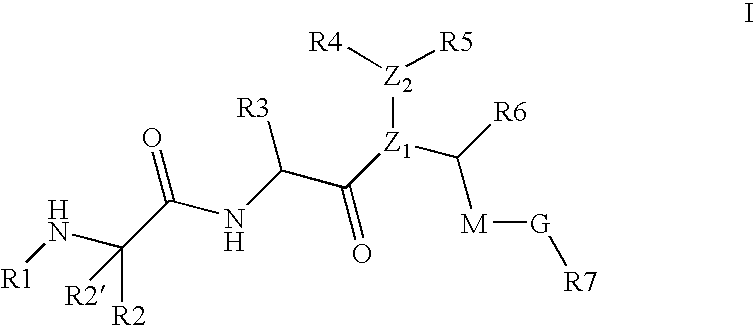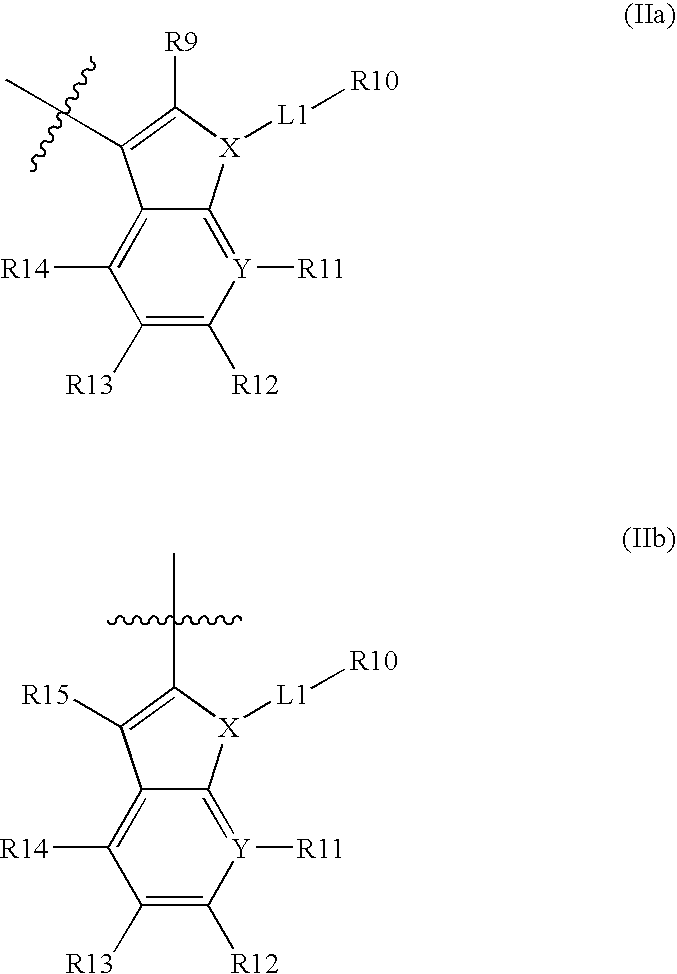[0006] Smac is synthesized in the
cytoplasm with an N-terminal
mitochondrial targeting sequence that is proteolytically removed during maturation to the mature polypeptide and is then targeted to the inter-membrane space of mitochondria. At the time of
apoptosis induction, Smac is released from mitochondria into the
cytosol, together with
cytochrome c, where it binds to IAPs, and enables
caspase activation, therein eliminating the
inhibitory effect of IAPs on
apoptosis, Whereas
cytochrome c induces multimerization of Apaf-1 to activate procaspase-9 and -3, Smac eliminates the
inhibitory effect of multiple IAPs. Smac interacts with essentially all IAPs that have been examined to date including
XIAP, c-IAP1, c-IAP2, ML-IAP, and
survivin. Thus, Smac appears to be a master
regulator of apoptosis in mammals.
[0014] Non-steroidal anti-inflammatory drugs (NSAIDs) have been shown to induce apoptosis in colorectal cells. NSAIDs appear to induce apoptosis via the release of Smac from the mitochondria (PNAS, Nov. 30, 2004, vol. 101:16897-16902). Therefore, the use of NSAIDs in combination with
Smac mimetics would be expected to increase the activity each
drug over the activity of either
drug independently.
[0020] Another embodiment of the present invention is the therapeutic combination of compounds of the present invention with TRAIL or other chemical or biological agents which bind to and activate the TRAIL
receptor(s) TRAIL has received considerable attention recently because of the finding that many
cancer cell types are sensitive to TRAIL-induced apoptosis, while most normal cells appear to be resistant to this action of TRAIL. TRAIL-resistant cells may arise by a variety of different mechanisms including loss of the
receptor, presence of
decoy receptors, or overexpression of FLIP which competes for
zymogen caspase-8 binding during DISC formation. In TRAIL resistance,
Smac mimetics increase tumor
cell sensitivity to TRAIL leading to enhanced cell death, the clinical correlations of which are expected to be increased apoptotic activity in TRAIL resistant tumors, improved clinical response, increased
response duration, and ultimately, enhanced
patient survival rate. In support of this, reduction in
XIAP levels by
in vitro antisense treatment has been shown to cause
sensitization of resistant
melanoma cells and
renal carcinoma cells to TRAIL (Chawla-Sarkar, et al., 2004). The Smac mimetics disclosed herein bind to IAPs and inhibit their interaction with caspases, therein potentiating TRAIL-induced apoptosis.
[0027] A combination of a Smac
peptidomimetic and a chemotherapeutic /
anti neoplastic agent and / or
radiation therapy of any type that activates the intrinsic pathway may provide a more effective approach to destroying
tumor cells. Smac peptidomimetics interact with IAP's, such as
XIAP, cIAP-1, cIAP-2, ML-IAP, etc., and block the IAP mediated inhibition of apoptosis while chemotherapeutics /
anti neoplastic agents and / or
radiation therapy kills actively dividing cells by activating the intrinsic apoptotic pathway leading to apoptosis and cell death. As is described in more detail below, embodiments of the invention provide combinations of a Smac pepidomimetc and a chemotherapeutic / anti-neoplastic agent and / or
radiation which provide a synergistic action against unwanted cell proliferation. This synergistic action between a Smac
peptidomimetic and a chemotherapeutic / anti-neoplastic agent and / or
radiation therapy can improve the efficiency of the chemotherapeutic / anti-neoplastic agent and / or
radiation therapy. This will allow for an increase in the effectiveness of current chemotherapeutic / anti-neoplastic agents or radiation treatment allowing the
dose of the chemotherapeutic / anti-neoplastic agent to be lowered, therein providing both a more effective dosing schedule as well as a more tolerable
dose of chemotherapeutic / anti-neoplastic agent and / or
radiation therapy.
 Login to View More
Login to View More 


